Not just Boracay...
Your Comprehensive Umrah Guide: Things to Do When Going For Pilgrimage
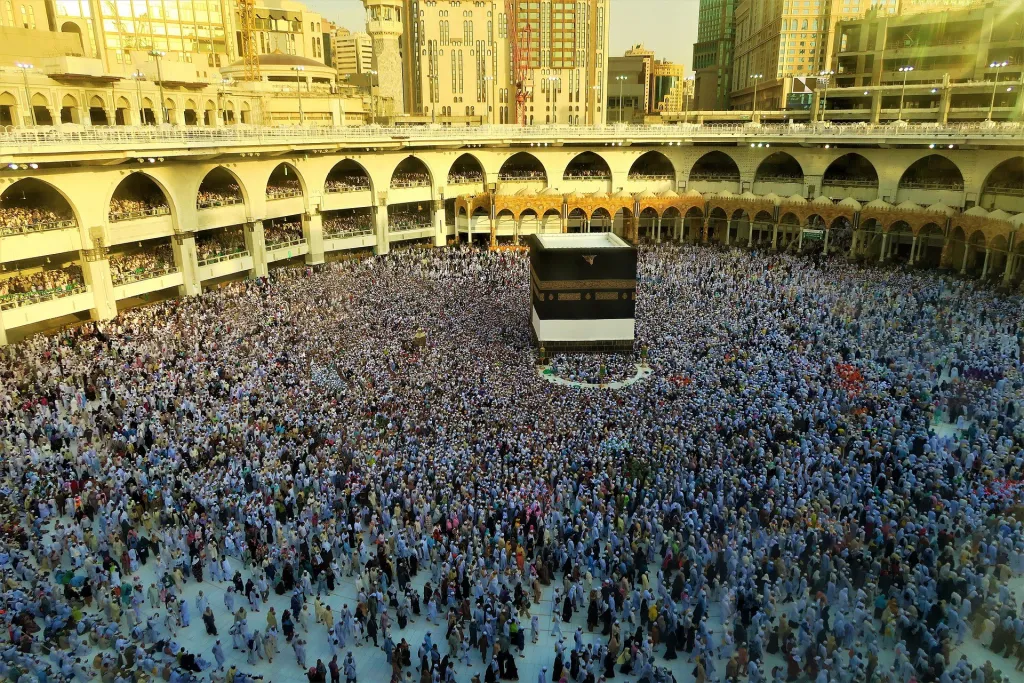
Umrah and Hajj are highly spiritual Islamic pilgrimages that bring Muslims closer to the divine and offer them a chance to connect with their faith in a profound manner. As you embark on this spiritual journey, it’s important to prepare yourself with the right mindset, knowledge, and guidance to make the most of this blessed experience.
That’s why we’ve created this comprehensive Umrah guide and a bonus step-by-step Hajj guide to help you navigate through the various rituals and practices, while highlighting some of the best things to do while you’re making the pilgrimages to enrich your experience.
What’s more, with the latest announcements by SAUDIA Group stating the allocations of over 1,000,000 and 200,000 seats during the Hajj season of 2023, pilgrims can now fly with ease and comfort at the top of their minds.
Some of the exceptional services offered by SAUDIA Group include the issuance of boarding passes for the arrival and return flights from international departure and domestic terminals, coordinating the dispatch of Zamzam water bottles to multiple destinations, as well as providing additional flights for pilgrims wishing to travel to Medina by air. Did we also mention that Saudia Airlines now has an updated in-flight Islamic content related to Hajj in more than 14 languages?
If you’re planning on making these holy pilgrimages soon, this blog provides the perfect guides for both first-timers and seasoned travellers alike. So, let’s begin this transformative journey together and discover the things you can do to make your journey a truly unforgettable experience.
Also read: EXPLORING THE WORLD’S TOP 10 MOST BEAUTIFUL MOSQUES
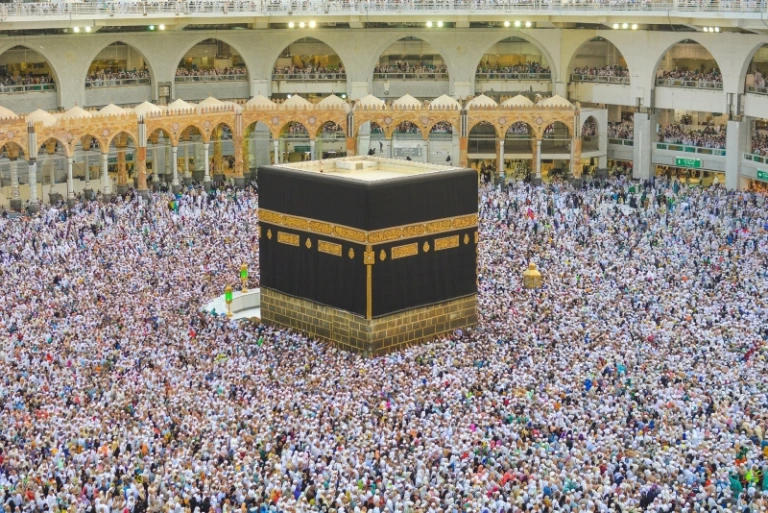
Pre-Umrah Preparations
1. Travel Arrangements
Making travel arrangements can be overwhelming, especially if it’s your first time performing Umrah. It’s important to book your flights, accommodation, and ground transportation in advance to avoid any last-minute stress. You’ll also need to apply for a Umrah visa, which can be done through a licensed Umrah agent or through the Saudi embassy.
However, if you are planning on making a short visit for Umrah, you can also avail a 72-hour visa processed by the Saudi Airlines, which is also the official airlines of the Kingdom of Saudi Arabia.
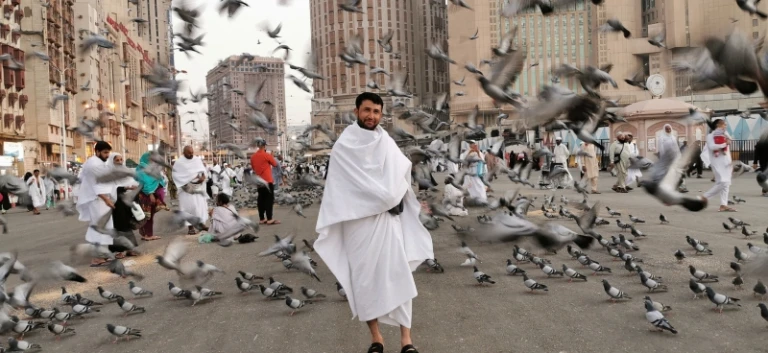
Once you have sorted out your visas, the next important step is to get your accommodation in order. It is highly recommended to make your hotel booking reservations at least 30 days before your arrival to ensure availability and avail more reasonable rates. The closer your hotel is to the Haram, the more expensive it tends to be, so consider your priorities and budget accordingly.
Some of the websites through which you can get your hotel reservation sorted are Booking.com, Expedia.com, Agoda.com to name a few. These websites offer a range of options for accommodations in Makkah and Madinah, with various prices, amenities, and locations.
However, if you prefer to have a hassle-free and comprehensive Umrah experience, it’s highly recommended to book your accommodation through a licensed Umrah agent. These agents have established partnerships with hotels and can offer Umrah packages that include transportation, meals, and guided tours.
2. Items to Pack
Packing for Umrah requires careful consideration to ensure that you have all the necessary items to make your journey comfortable and stress-free. Here’s a list of essential items to pack for Umrah:
- Ihram Clothing
- Comfortable Shoes
- Prayer Mat
- Personal Hygiene Items
- Umbrella and Sunscreen
- Power Bank and Adapters
- Backpack or Small Bag
3. Assuming the State of Ihram
Assuming the state of Ihram is a crucial aspect of performing Umrah, and there are specific times and places where Ihram should be worn. Miqat refers to the designated points where pilgrims must assume the state of Ihram before entering the Holy City of Makkah.
For Muslims travellers making the journey from abroad, it is important to understand when and where to assume the state of Ihram. Men must wear the Ihram clothing before they cross the Miqat boundary, which is typically located at a distance of around 50 to 80 kilometres from Makkah. Women can wear their regular clothing but should ensure that it’s modest and covers their entire body, except for their face and hands.
It is recommended that Muslim travellers coming to Makkah from abroad assume the state of Ihram before leaving their homes to make the process more hassle free as it may be difficult for men to change into the Ihram clothing in-flight.
4. Post-landing
After safely landing at the King Abdulaziz International Airport in Jeddah, pilgrims can begin their Umrah journey. After landing, pilgrims must go through immigration and customs checks. Make sure to have all your travel documents and visas in order and ready for inspection. You may also be asked to declare any items that you’re bringing into the country.
There are several options for ground transportation from the airport to Makkah, such as through the Haramain train terminal, taxis, buses, or private cars. You can also book your transportation in advance through a licensed Umrah agent or at the airport upon arrival.
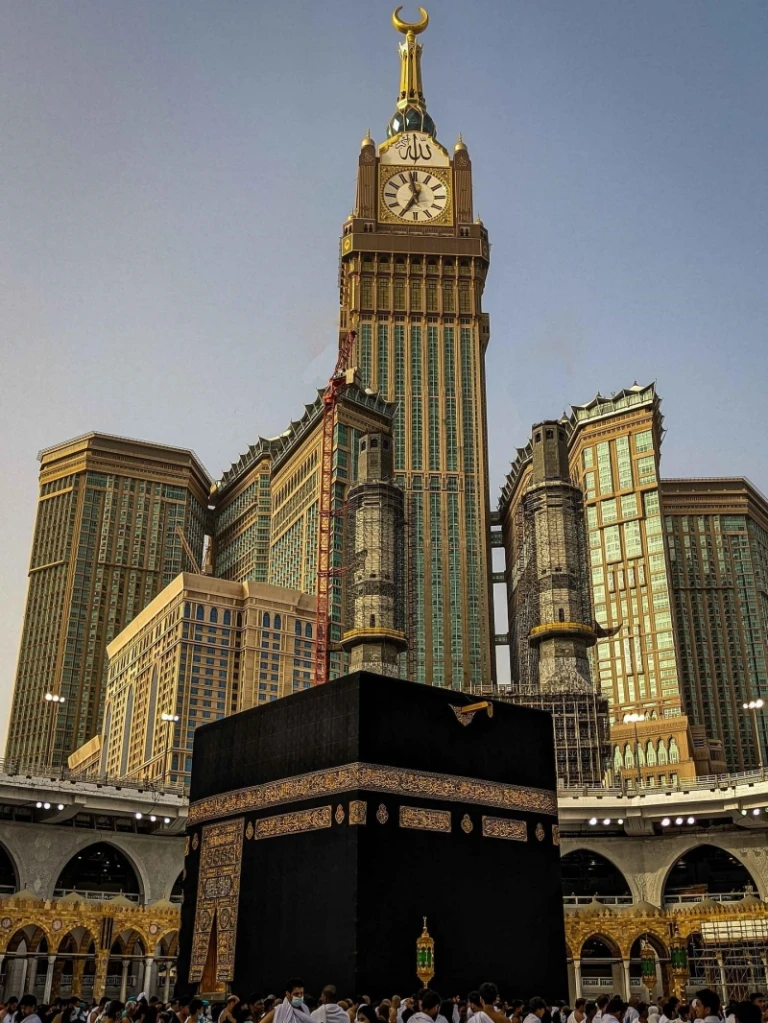
Rituals and Practices
The Umrah pilgrimage is a journey that involves several rituals and practices that hold great significance for Muslims around the world. Here’s a brief overview of some of the key Du’as (supplications) and practices that you’ll have to perform during your Umrah journey:
1. Tawaf
Tawaf is the act of circumambulating the Kaaba, which is the cubic structure located at the centre of the Holy Haram in Makkah. Pilgrims perform seven circuits of Tawaf in a counter-clockwise direction, beginning at the corner of the Kaaba known as the Black Stone. It’s recommended to recite specific supplications and prayers during Tawaf. After the Tawaf is completed, two Nafil Rak’ah’s should be performed before starting the Sa’i.
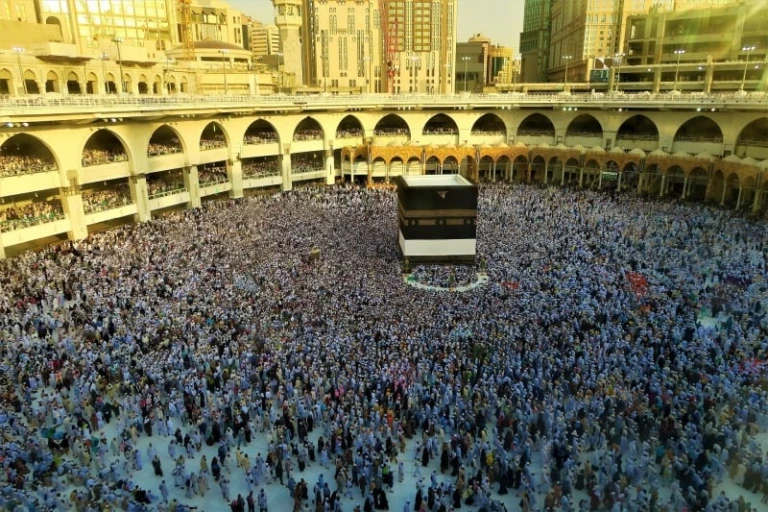
2. Sa’i
After completing Tawaf, pilgrims proceed to perform Sa’i, which involves walking back and forth between the hills of Safa and Marwah. This ritual commemorates the actions of Hajar, the wife of Prophet Ibrahim, who ran between the hills in search of water for her infant son Ismail. Pilgrims perform seven rounds of Sa’i, beginning at Safa and ending at Marwah.
3. Halq or Taqsir (Shaving of the head)
After completing Tawaf and Sa’i, men must shave their heads (Halq) or trim their hair (Taqsir), while women cut a small portion of their hair. This marks the end of the Ihram state and symbolises the completion of the Umrah journey.
4. Du’a and Supplications:
Throughout the Umrah journey, it’s recommended to recite specific supplications and prayers, seeking forgiveness and guidance from Allah. Pilgrims can also offer voluntary prayers and perform acts of charity to increase their reward and strengthen their faith.
Bonus: brief step-by-step Hajj guide
Performing Hajj is one of the Five Pillars of Islam, which means Muslims are expected to complete the ritual at least once in their lifetime (if they can afford to do so). Unlike Umrah, which can be performed throughout the year, the Hajj pilgrimage only occurs during the month of Dzulhijjah (the last month in the Islamic calendar).
Preparing for Hajj can be more daunting than Umrah. So, allow us to walk you through the step-by-step process of performing Hajj:
Day-1: Tarwiyah Day (8th Dzulhijjah)
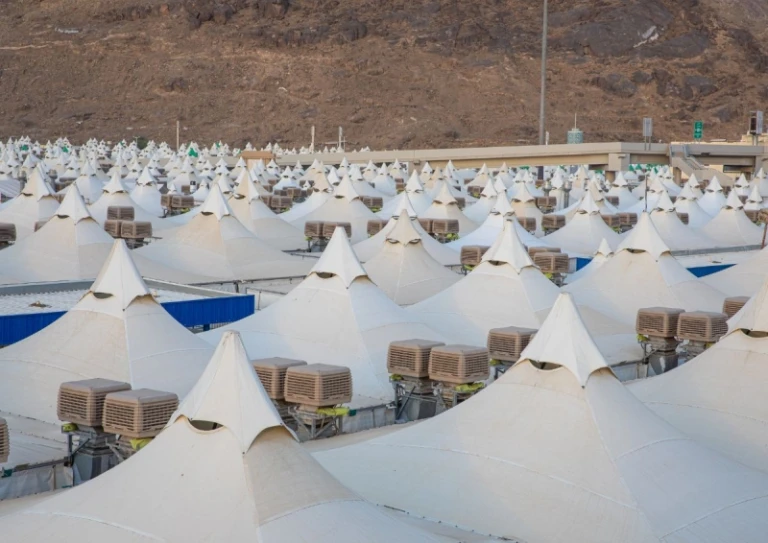
*Note: Once pilgrims enter the state of Ihram, they should start reciting Talbiyah whereby they make the intention to make Hajj in the Holy Land. This is usually done on the airplane before they land in Mecca.
After performing their Fajr prayers in Mecca, pilgrims will walk (or some take a bus ride) to Mina (a town in Mecca). Talbiyah should be recited throughout the journey.
Upon reaching the “City of the Tents,” pilgrims will perform the other three obligatory prayers (on 8th Dzulhijjah) and spend the night in Mina. Do note that Zohor, Asar, and Isyak prayers are shortened to two Rakaat each (qasar) and will be performed during their respective time.
Day-2: Arafah Day (9th Dzulhijjah)
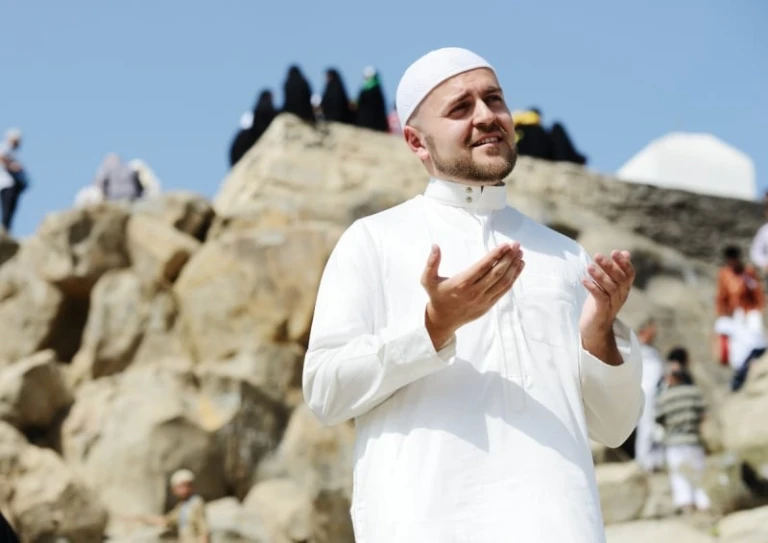
On the day of Arafah, pilgrims are to perform their Fajr prayers in Mina and have to remain there until dusk. The journey to Arafah will only begin after sunrise, accompanied by frequent Talbiyah and Takbir by the pilgrims throughout the journey. Dzikr, istighfar and other supplications can also be recited along the way.
Pilgrims will reach Arafah before Zohor. And when it’s time to pray, Zohor and Asar prayers will be combined (jamak) near Jabal al-Rahmah. And they are to remain within the border of Arafah until sunset. This integral rite is known as Wuquf (standing/being present at a particular place during Hajj even for a moment). Now what happens after sunset? The pilgrims will continue their journey to Muzdalifah (a town between Mina and Arafah) as they recite the Talbiyah and other supplications in remembrance of Allah. Once they reach the town, Maghrib and Isyak prayers will be performed together.
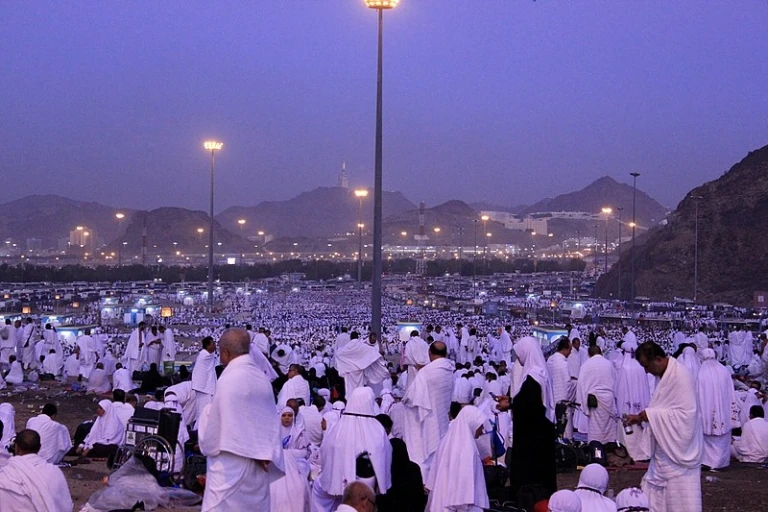
Pilgrims may start picking seven small pebbles (or 49, or 70) at night or they can do that after Fajr prayer the next day. These pebbles will be used for stoning at Jamarat ritual on 10th Dzulhijjah. Are they to spend the night of 9th Dzulhijjah in Muzdalifah? Yes. And that completes the second day of Hajj.
Day-3: First Day of Eid (10th Dzulhijjah)
On the third day, the pilgrims in Muzdalifah will travel to throw pebbles at the pillars. Today, Muslims all over the world and in Hajj celebrate Eid Al-Adha.
Jamarat Al-Aqabah: Devil stoning
After performing the Fajr prayer on 10th Dzulhijjah, pilgrims are to remain there until sunrise. The long day begins with them travelling back to Mina while reciting Talbiyah. Upon arrival, the pilgrims will head to Jamarat Al-Aqabah to throw the seven pebbles at the largest pillar among the three stoning sites.
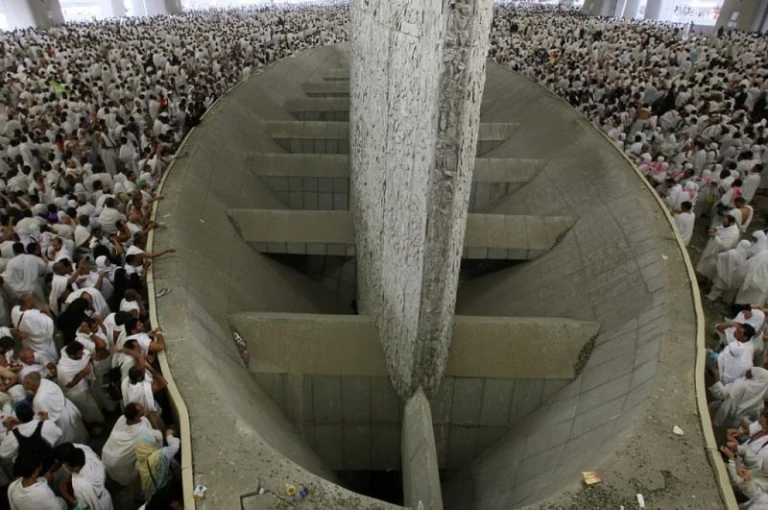
Right before the first throw, pilgrims will stop reciting Talbiyah. Instead, they will recite Allahu Akbar with every throw (Rami). This ritual is a significant ritual that dates back to the test of Prophet Ibrahim a.s. It symbolically demonstrates the act of ‘stoning the devil’ in an attempt to reject temptation and affirm one’s faith in Allah.
Animal sacrifice (Nahr)
This activity is an integral part of Hajj which is also the culmination of the stoning ritual. The pilgrims may slaughter a camel, a cow, a sheep, or a goat (whichever they can afford) which will then be fed to the poor.
Shaving the head (Halq) or Trimming the hair (Taqsir)
The act of shaving or trimming one’s hair indicates that a pilgrim is partly out of ihram. In this ritual, men will need to shave or trim their hair. Though it’s not compulsory for men to completely shave their hair, the act is advisable and part of Sunna or the way of the Prophet Mohammed. As for women, they are only allowed to trim their hair.
Return to Kaabah for Tawaf and Sa’i
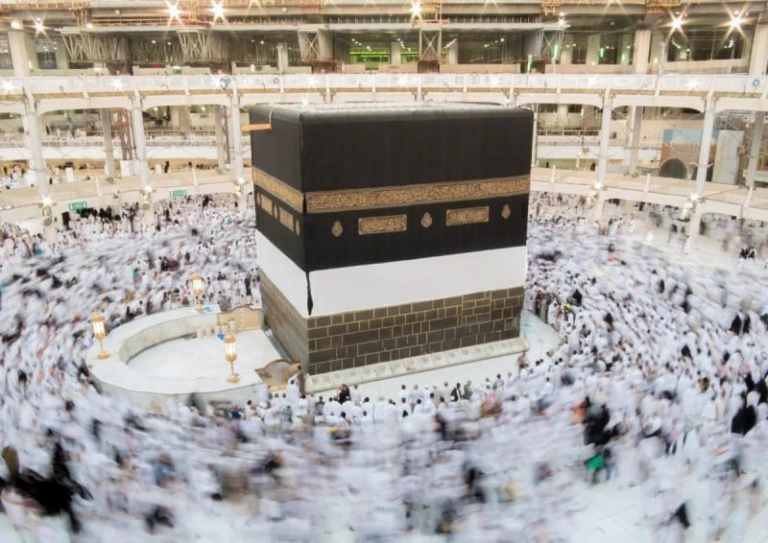
Afterwards, the pilgrims would return to Masjid Al-Haram in Mecca to perform Tawaf Al-Ifadah, where they would circle the Kaaba for seven times. After completing all the rounds, pilgrims are to perform two rakaat of salah for Tawaf in front of Maqam Ibrahim (if possible) or wherever in the mosque, or anywhere that faces the holy site. The pilgrims will then proceed with the Sa’i ritual that requires them to travel from Safa to Marwa seven times. Upon completion of these steps, pilgrims return to Mina and remain there overnight. And with that, the third day of Hajj is completed.
Day-4: 2nd Day of Eid (11th Dzulhijjah)
During their final days in Mina, the pilgrims will again symbolically stone the devil at all three pillars (Jamarat-al-Oola, Jamarat-al-Wusta and Jamarat Al-Aqabah). With that being done, they will spend the next two to three days in Mina praying, supplicating, and remembering Allah.
Perform the Farewell Tawaf
Tawaf around Kaaba | Image credit: Zurijeta via Canva Pro
After spending days in Mina, pilgrims will return to Mecca to perform Tawaf Wada’ or Farewell Tawaf, the final circulation of Kaaba. It’s best to make full use of this time to reflect on their entire Hajj experience and be grateful to Allah for welcoming them to the holy land.
Many would visit Madinah (the second holiest city in Islam) before departing home, mainly to shop for souvenirs and to visit the three prominent mosques in Islam which will be explained in detail below.
Exploring the Holy Sites
Exploring the Holy Sites in Makkah and Madinah is a significant part of the Umrah and Hajj journeys. These cities are home to several historical and religious landmarks that hold immense spiritual significance for Muslims worldwide. Here’s what you need to know about exploring the Holy Sites during your sacred pilgrimages:
1. Maqam Ibrahim
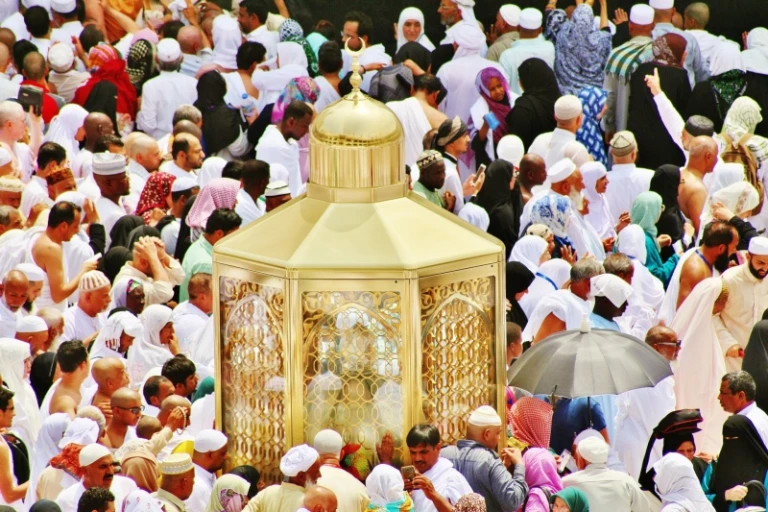
Maqam Ibrahim is a significant landmark located within the Holy Haram in Makkah. It’s a small stone structure that contains the footprint of Prophet Ibrahim (peace be upon him), who is considered a patriarch of monotheistic religions.
The Maqam Ibrahim is located adjacent to the Kaaba, and it’s recommended to offer two Rak’ahs of Salah after performing Tawaf. According to Islamic tradition, the stone on which the footprint is imprinted miraculously rose to support Prophet Ibrahim while he was building the Kaaba.
2. Cave of Hira
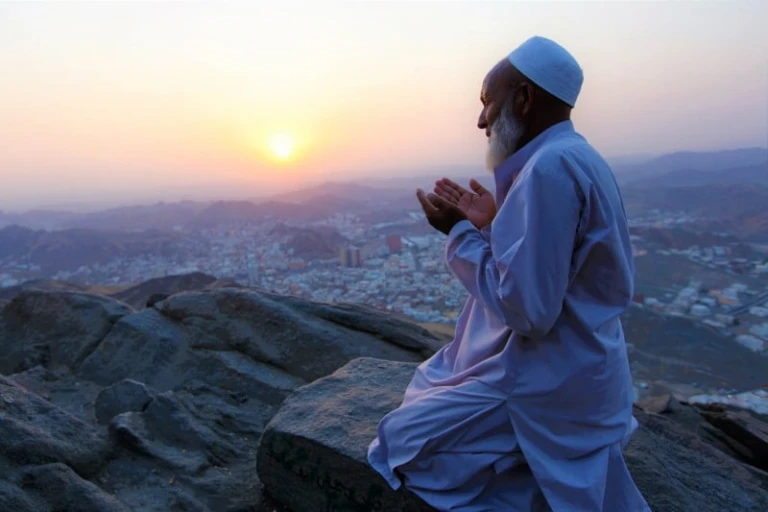
The Cave of Hira is a small cave located on the outskirts of Makkah and holds immense significance in Islamic history. It’s the site where Prophet Muhammad received the first revelation of the Quran from Allah, through the Angel Jibreel.
The cave is located on the Jabal al-Nour mountain and requires a 2.5 km hike to reach the summit. Pilgrims can visit the cave and offer supplications, seeking guidance and blessings from Allah.
3. Masjid Al Nabawi (The Prophet’s Mosque)
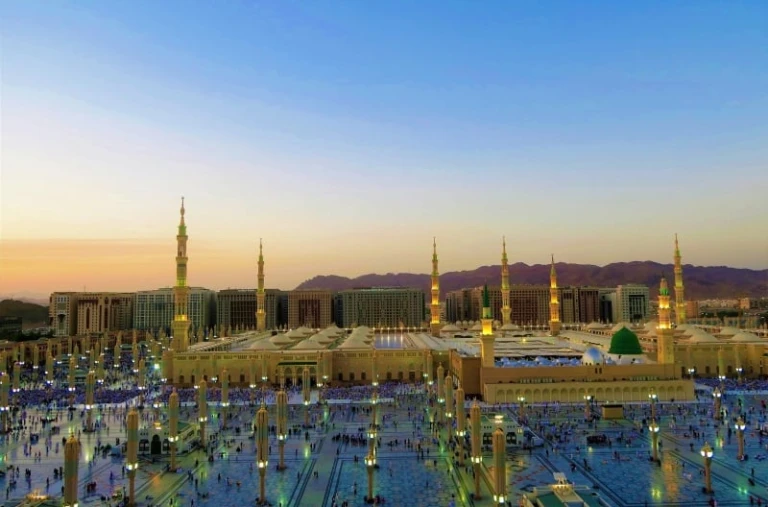
Masjid Al Nabawi is the second holiest mosque in Islam and is located in the city of Madinah. It’s the final resting place of Prophet Muhammad and holds immense spiritual significance for Muslims worldwide.
Madinah is located around 400 kms away from Makkah and travellers can make the journey either via the Haramain train, local taxi, buses or also through an air flight from the King Abdulaziz Airport in Jeddah.
When visiting the Masjid Al Nabawi, it is highly recommended to offer Salah in the mosque and to visit the Rawdah, the area between the Prophet’s tomb and his pulpit, which is considered a blessed area.
Visiting Masjid Al Nabawi is a spiritually uplifting experience that allows pilgrims to connect with the legacy of Prophet Muhammad and the essence of Islam.
4. Mount Uhud
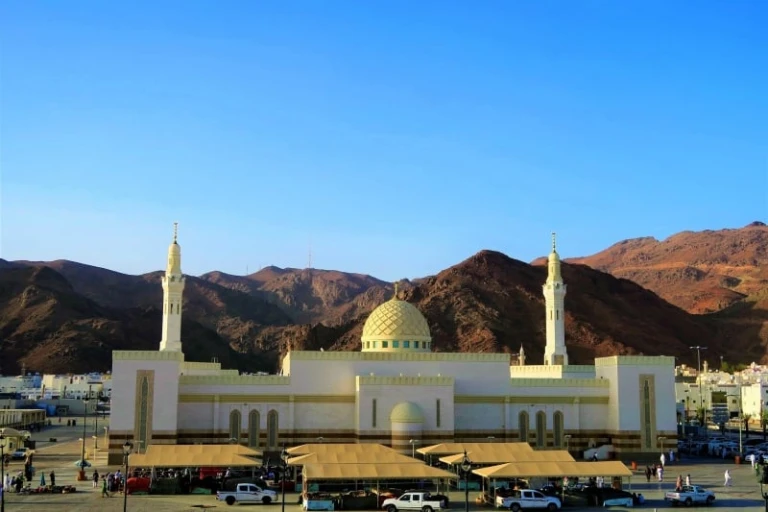
Mount Uhud is a mountain range located a few kilometres away from the Prophet’s Mosque in Madinah and holds significant historical importance in Islamic history. It’s the site of the Battle of Uhud, which was fought between the Muslims of Madinah and the Meccan army in 625 CE.
The battle resulted in a victory for the Meccan army but also served as a lesson for the Muslims on the importance of obedience and steadfastness in the face of adversity. Visiting Mount Uhud offers pilgrims an opportunity to reflect on the importance of sacrifice and resilience in Islam and to seek blessings and forgiveness from Allah.
5. Quba Mosque
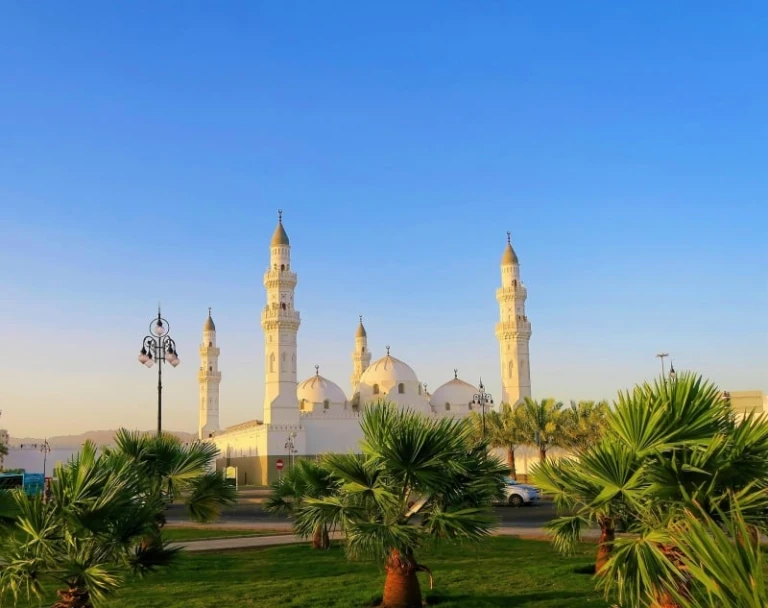
Quba Mosque is a mosque located on the outskirts of Madinah and holds significant religious importance in Islam. It’s the first mosque built by Prophet Muhammad upon his arrival in Madinah and served as a place of worship and community gathering for the Muslims.
Travellers can also visit gardens surrounding the Quba Mosque where some of the best dates are grown in the region. The gardens offer a serene and peaceful atmosphere, making it an ideal place for relaxation and contemplation.
Visiting Quba Mosque is a spiritually uplifting experience that allows pilgrims to connect with the legacy of Prophet Muhammad.
6. Masjid al-Qiblatayn
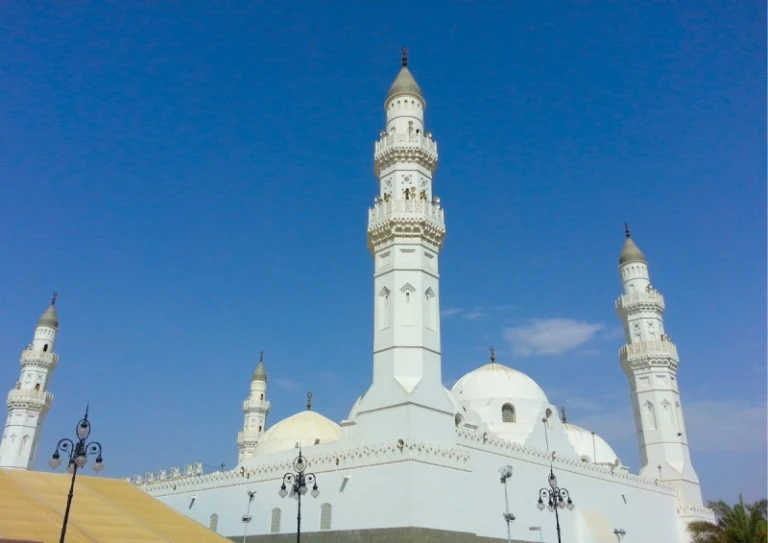
Masjid al-Qiblatayn, or “Mosque of Two Qiblas,” is among the oldest mosques in Islam, along with Masjid Quba and Masjid al-Nabawi. The mosque is located in Madina and is believed to be where Prophet Muhammad received the command to change the qibla (direction of prayer) from Masjid al-Aqsa in Jerusalem to Kaaba in Mecca.
This beautiful mosque, built in the year 2 AH (623 CE), is significant to Islamic history as it is where the first congregational prayer was performed following the change of qibla. If you didn’t know yet, this historical building is among the few mosques in the world with two mihrabs!
Common Mistakes and How to Avoid Them
Mistake 1: Shouting the supplications in unison
During Tawaf, some people follow an Imam or a leader who shouts out different Du’as aloud, and the followers repeat them in unison at the top of their voices. However, this can cause confusion and disturb others who are trying to focus on their own supplications.
It’s recommended to perform Du’a in a calm and composed manner, maintaining focus and sincerity. Pilgrims should also be mindful of their surroundings and avoid disturbing others. This can be achieved by performing Du’a in a low voice and avoiding following an Imam or a leader who shouts out Du’as aloud.
Mistake 2: Disregarding Ihram restrictions
Please note that while in the state of Ihram, there are several restrictions that pilgrims must abide by, such as refraining from cutting hair, trimming nails, using perfume, and engaging in any intimate acts with their spouse. The shaving of the head is only performed after the completion of the Umrah, which also indicates the end of the Umrah pilgrimage.
Mistake 3: Purchasing Zamzam water from local shops
Many tourists purchase the Zamzam water before travelling to the airport from local shops. However, it’s better to purchase the Zamzam water from authorised sellers located at the King Abdulaziz Airport.
This will ensure that the travellers do not have to carry heavy bottles with them on their way to the airport. Please note that as of recently, one passenger is only allowed to check-in with a maximum of 5 litres of Zamzam water.
The Umrah and Hajj journeys are deeply spiritual and transformative experiences that hold significant importance in Islam. By following the guidelines and recommendations in this comprehensive guide, pilgrims can ensure a smooth journey alongside a memorable experience.
Published at
About Author
Azmi Anees
Subscribe our Newsletter
Get our weekly tips and travel news!
Recommended Articles
10 Best Halal-Friendly Destinations in The Philippines for Muslim Travellers The 10 Best Indonesian Restaurants in Mecca and Madinah for Hajj and Umrah Pilgrims comforting flavor of Nusantara cuisine while Umrah
10 Best Places for Muslim Travellers to See Tulip Festivals in 2025 Fun Fact: Tulips didn’t actually come from the Netherlands but Türkiye!
10 Halal Anime Food Guide for Muslim Travellers in Japan Muslim-friendly versions of popular anime dishes across Japan!
Top 10 Popular Muslim-Friendly Destinations to Visit in 2025 Our schedules are packed, buddies!
Latest Articles
Thailand-Cambodia Conflict 2025: Muslim-Friendly Travel Precautions & Tips At least 438,000 civilians evacuated!
AirAsia Introduces Hijab Option for Muslim Cabin Crews Alhamdulillah, all female Muslim crew will officially have the choice to wear the hijab on any AirAsia flight
The Ultimate Guide to Spending New Year in Tokyo: Tips for Muslim Travellers Tokyo offers different kind of festivities during new year, but there are things you have to know before visiting.
Jimbocho, Tokyo: Explore the Coolest Neighbourhood in the World 2025, Muslim-Friendly Style There's a reason why you should visit the world's coolest neighborhood.
Muslim-Friendly Guide for Exploring Song Wat: Bangkok’s Trendy Heritage District This is your sign to visit Bangkok's hottest lifestyle hub.

